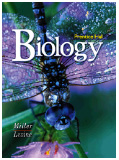BIOLOGY
by Miller & Levine
[complete Table of Contents]

|
Use the pull-down menu to jump to any of the Book's 40 Chapters: |
Additional Resources:
| Hot Links | Chapter Self-Test |
| Take it to the Net | Teaching Links |
What are Web Codes? |
Web
Codes for Chapter 31: |
![]()
In this chapter, students will read about the adaptations
of reptiles and birds and the major living groups that make up these two
classes of chordates.
Section 31-1: Reptiles
![]() A reptile is a
vertebrate that has scaly skin, lungs, and eggs with several membranes.
A reptile is a
vertebrate that has scaly skin, lungs, and eggs with several membranes.
![]() Well-developed
lungs; a double-loop circulatory system; an efficient excretory system;
strong limbs; internal fertilization; and shelled, terrestrial eggs are
the main adaptations that have contributed to the success of reptiles
on land.
Well-developed
lungs; a double-loop circulatory system; an efficient excretory system;
strong limbs; internal fertilization; and shelled, terrestrial eggs are
the main adaptations that have contributed to the success of reptiles
on land.
![]() The four surviving
orders of reptiles are lizards and snakes, crocodilians, turtles and tortoises,
and the tuatara.
The four surviving
orders of reptiles are lizards and snakes, crocodilians, turtles and tortoises,
and the tuatara.
Section 31-2: Birds
![]() Birds are reptilelike
animals that maintain a constant internal body temperature. They have
an outer covering of feathers, two legs that are covered with scales and
are used for walking or perching, and front limbs modified into wings.
Birds are reptilelike
animals that maintain a constant internal body temperature. They have
an outer covering of feathers, two legs that are covered with scales and
are used for walking or perching, and front limbs modified into wings.
![]() Birds have a number
of adaptations that enable them to fly. These adaptations include highly
efficient digestive, respiratory, and circulatory systems; aerodynamic
feathers and wings; and strong chest muscles.
Birds have a number
of adaptations that enable them to fly. These adaptations include highly
efficient digestive, respiratory, and circulatory systems; aerodynamic
feathers and wings; and strong chest muscles.
Click Here for Science News articles on Chordates and Vertebrates